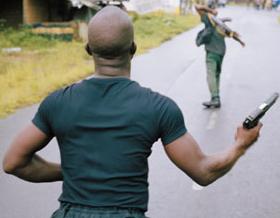The younger Taylor and his soldiers are accused of torturing captives by burning them with cigarettes, dripping molten wax or plastic on them and confining them naked in pits covered with iron bars and shoveling stinging ants on them. They poured boiling water into the cupped hands of one victim while holding a gun to his head, implying the victim would be killed if he let a drop of water spill to the ground.....In one incident, the indictment alleges that Taylor stopped a group of suspected rebels near a checkpoint at the St. Paul River bridge at Gbalatuah, Liberia, picked out three people and "summarily shot them in front of others in the group."At the paramilitary unit's base, the indictment said, Taylor ordered his soldiers to cut off a captive's head. They held the victim's head over a bucket and severed it by slitting his throat from back to front after he begged for his life.
The summary execution of Sierra Leoneans by people now enjoying special privileges under the President Ernest Koroma regime is an open secret and his continued protection of the likes of "Leatherboot" his chief aide should be condemned by all. These people must be made to pay for their crimes.
Freetown residents could well recall individual acts of rape, murder and torture carried out by forces loyal to war crimes fugitive Johnny Paul Koroma.
The Sierra Herald would urge all those who witnessed the deliberate murder, rape, torture and dispossession of civilians to come forward and tell their story for their tormentors to be brought to justice.
Residents in the Kanikay area of the city, in the east of the capital Freetown are now urged to forward details of the woman shot dead in 1997 by a uniformed and armed junta gun man who did not like the comment made by the woman when after hearing the voice of the ousted President Ahmad Tejan Kabbah for the first time on the new FM 98.1 radio commented "Di Pa Talk Fine".
For that the poor woman lost her life.
Keepers at the morgue of Connaught Hospital are reminded of that body that was brought in on a Military Police open landrover and being told that they should not talk to any journalist on pain of death!!!
We would urge them to come forward now!!!!
We need justice for that woman who was shot out of hand. Summarily executed. A defenceless woman, unarmed - merely expressing the novelty of hearing a new radio station and merely expressing her opinion.
And this Kanikay woman was not the only victim. Part of a report on the violence perpetrated on women and girls well documented by many rights groups is a grim reminder that a blanket amnesty is not applicable. All those who can be identified as carrying out such acts must be named and brought to justice.
Indiscriminate killings, amputations, rapes, and abductions characterized Sierra Leone’s decade-long conflict. The crimes of sexual violence committed against thousands of women and girls were extraordinarily brutal and were often accompanied by other egregious abuses of the victim and her family. Women of all ages were raped, including those who were pregnant at the time. Many women died as a consequence of the violence of their rapes while others miscarried. Many will suffer lifelong health problems as a consequence of the violence.
In addition, violence against women was employed to attack their loved ones and their children. Family members were often forced to watch the rape of their wives, mothers, or daughters as a means of further terrorizing and subjugating the women and their communities. Young women and girls who the rebels thought were virgins were particularly targeted for rape and sexual slavery; many of the younger victims did not survive. Adult women were raped so violently that they sometimes bled to death or suffered irreparable tearing in the genital area, causing long-term incontinence and severe infections. Numerous pregnant women had their bellies slit open by rebels who placed bets on the sex of the foetus.
Rebels abducted thousands of women and girls and subjected them to sexual slavery, forcibly conscripted them into the rebel forces, or “married” them to members of the rebel force. The women were held for prolonged periods of time. Aside from sexually servicing rebel fighters, “civilian” abductees (those not conscripted) were also required to perform forced labor, such as cooking, washing, and portering (carrying ammunition and other looted items) for the rebels. Some of these women had children fathered by rebels.
Terrorized by their captors and by the coercive environment, the women and girls often felt powerless to escape. Some rebels made escape more difficult by carving the name of their faction into the chests of the abducted women and girls. If pro-government forces discovered these marked women and girls, they accused them of aiding the rebels and often killed them. Even for women who were able to escape, it was easy to be recaptured, sometimes by a different unit or by a different rebel faction.
Justice must be seen to be done.
Over to you.
